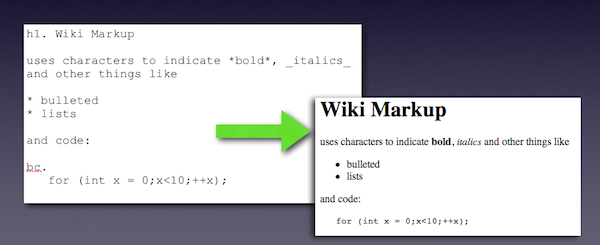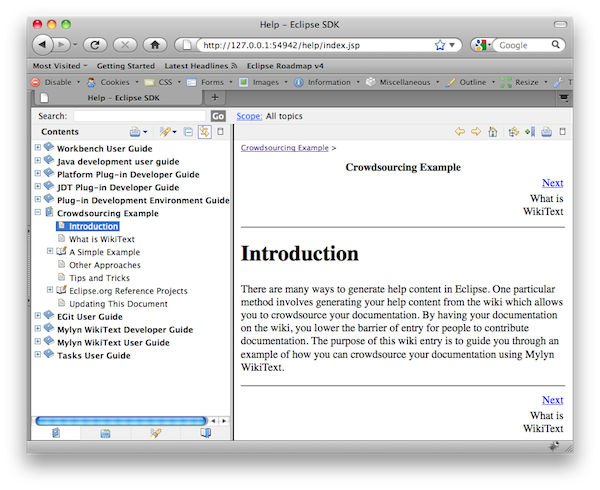Notice: This Wiki is now read only and edits are no longer possible. Please see: https://gitlab.eclipse.org/eclipsefdn/helpdesk/-/wikis/Wiki-shutdown-plan for the plan.
DocumentationGuidelines/CrowdSourcingExample
Contents
Introduction
There are many ways to generate help content in Eclipse. One particular method involves generating your help content from the wiki which allows you to crowdsource your documentation. By having your documentation on the wiki, you lower the barrier of entry for people to contribute documentation. The purpose of this wiki entry is to guide you through an example of how you can crowdsource your documentation using Mylyn WikiText.
What is WikiText
Mylyn WikiText provides an extensible framework and tools for parsing, editing and presenting lightweight markup. On top of that, it has a wiki text editor for Eclipse and Ant tasks for converting lightweight markup to HTML and other formats. In this specific example, we will be using WikiText's ability to convert Mediawiki content into Eclipse help content.
A Simple Example
The best way to learn is by doing. As an example, we will take this wiki entry and create some Eclipse help content from it. To accomplish this, we will use Ant so you can easily integrate this into a build if you wish.
Setting up the Classpath
The first order of business is to setup your Ant classpath so you can use the WikiText Ant tasks.
You can download the WikiText SDK which contains the jars you'll need. In our case, we only need the org.eclipse.mylyn.wikitext.core_1.3.0.I20100116-0000-e3x.jar and org.eclipse.mylyn.wikitext.mediawiki.core_1.3.0.I20100116-0000-e3x.jar since we are only working with Mediawiki. If we were working with something like confluence, we would have to grab the respective JAR and put it on our classpath.
In the end, your Ant file will look something like the snippet below.
<path id="wikitext.tasks.classpath"> <fileset dir="lib"> <include name="org.eclipse.mylyn.wikitext.*core*.jar"/> </fileset> </path> <taskdef classpathref="wikitext.tasks.classpath" resource="org/eclipse/mylyn/internal/wikitext/mediawiki/core/tasks/tasks.properties"/> <taskdef classpathref="wikitext.tasks.classpath" resource="org/eclipse/mylyn/wikitext/core/util/anttask/tasks.properties"/>
Converting to Eclipse Help
After we have setup the classpath for our task, we need to go and fetch the wiki content and convert it to Eclipse help. This is accomplished via the mediawiki-to-eclipse-help Ant task.
In the end, your Ant file will look something like the snippet below.
<mediawiki-to-eclipse-help wikiBaseUrl="http://wiki.eclipse.org" validate="true" failonvalidationerror="true" prependImagePrefix="images" formatoutput="true" defaultAbsoluteLinkTarget="doc_external" dest="${basedir}" title="Crowdsourcing Documentation" generateUnifiedToc="false"> <path name="DocumentationGuidelines/Example" title="Crowdsourcing Documentation" generateToc="true"/> ...
When the Ant task is executed... the wiki content will be transformed into HTML and a respective Eclipse help TOC XML will be generated.
When you self-host and launch Eclipse Help in the self-hosted instance, you should see this content there as shown below.
Source Code
The full source code for this example is available on GitHub.
Other Approaches
There are two main approaches when it comes to crowdsourcing documentation: wiki-based and file-based.
In this example, we focus on the wiki-based approach as it's the most collaborative approach. Anyone can contribute to documentation easily and the changes are instantly available online for people to see. The downside to this approach is that contributions are a bit less controlled which could impact quality depending on how a project structures its documentation process and depending on the wiki you choose, version history may be a bit harder to manage.
In the file-based approach, the origin of the content is only in the SCM and is transformed during build-time. The plus side to this is it's managed by your existing version control system. The two major downsides are that changes aren't immediately available to your users and that it's much harder to contribute to the documentation since you need to have commit access. There are merits to both approaches and it really depends on your needs. Thankfully, examples for both approaches can be found in the #Eclipse.org Reference Projects section.
Tips and Tricks
You can use <pageAppendum> to add some extra information to your documentation.
It's common to add a blurb about how to update the documentation so users can be informed that the documentation they are reading has been generating from the wiki.
Eclipse.org Reference Projects
If you're looking for other examples on how to crowdsource your documentation at Eclipse, the best place is to look and see what other Eclipse.org projects are doing.
Mylyn
The Mylyn project uses two wiki pages on Eclipsepedia for its documentation: Mylyn/User Guide and Mylyn/FAQ.
Each of these have their own Help table of contents, which are arranged into a common document via a top-level table of contents with links.
You can browse the source code here. Pay attention to build-helper.xml, which drives the generation tasks, and toc.xml, which links the generated table of contents into a single document.
EGit
The EGit project uses a single wiki page on Eclipsepedia for its documentation.
Check out the org.eclipse.egit.doc plug-in.
Xtext
The Xtext project uses a Textile and Wikitext for its documentation. The code is available in the org.eclipse.xtext.doc plug-in. The documentation is sourced from various Textile files stored in source control and then transformed at build-time. This is different from the previous two examples which used the wiki as the source of documentation.
Pay attention to the customBuild.xml and the doc folder.
OSEE
For modularity reasons, the OSEE project has multiple help projects which generate Eclipse online help from different parts of the OSEE wiki. The central help plugin is org.eclipse.osee.framework.help.ui, which contains a build-helper.xml file that calls mediawiki-to-eclipse-help and specifies the different help chapters:
<mediawiki-to-eclipse-help wikiBaseUrl="${osee.help.doc.url.base}" validate="true" failonvalidationerror="true" prependImagePrefix="images" formatoutput="true" defaultAbsoluteLinkTarget="osee_external" dest="${basedir}" navigationimages="true" title="OSEE User's Guide" generateUnifiedToc="true"> <path name="OSEE/Users_Guide/Getting_Started" title="Introduction" /> <path name="OSEE/Users_Guide/Concepts" title="Concepts" /> <path name="OSEE/Users_Guide/Features" title="Features" /> <path name="OSEE/Users_Guide/Tips" title="Tips" /> <path name="OSEE/Users_Guide/New" title="New" /> <stylesheet url="book.css" /> <pageAppendum> = Updating This Document = This document is maintained in a collaborative wiki. If you wish to update or modify this document please visit {url} </pageAppendum> </mediawiki-to-eclipse-help>
Classpath/taskdef setup is performed in help-build-common.xml. Another example of an OSEE help plugin is org.eclipse.osee.ats.help.ui, which uses the libraries and taskdefs from org.eclipse.osee.framework.help.ui.
PsychoPath XPath 2.0 Processor
The PsychoPath Processor documentation is maintained on the eclipse wiki. The documentation is then generated into DocBook format using Mylyn WikiText. The documentation is then cleaned up as some of the conversions do not necessarily fit our specific needs. The Docbook Project's XSL stylesheets are then used to generate the help into a variety of formats including eclipse help.
- See Authoring_Eclipse_Help_Using_DocBook for more information on using Docbook to generate the final output produced by WikiText.
XSL Tools
Like the Psychopath Processor, the webtools XSL Tools documentation is also available on the wiki and generated back into DocBook format using Mylyn WikiText.
- See Authoring_Eclipse_Help_Using_DocBook for more information on using Docbook to generate the final output produced by WikiText.



